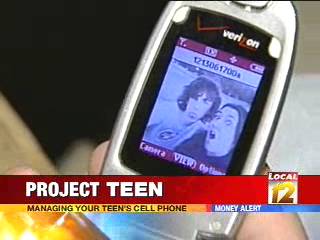The study “Teenagers: A Generation Unplugged” by the wireless trade association CTIA and Harris Interactive reports that cell phones have become a vital part of a teen’s identity. The coolness of the cell phone is considered a marker for popularity and status and having a phone is essential to a teen’s social life. (While most teens agreed that the iPhone was the coolest phone, most teens had a ‘conventional’ cell phone. Few could manage the high cost of the phone and the rates charged by AT&T.) The study results were announced at the CTIA Fall 2008 trade show. (See the overview at CNET.com)
 Photo credit: Local12. com
Photo credit: Local12. com
The importance of a cell phone to teen identity matters to cell phone makers and network operators because teens are a huge demographic. (A recent CNET review is entitled “Top Cell Phones for Teens”.) In fact, four out of 5 teens carry a cell phone with total cell phone owners up 40% since 2004. A Nielsen study reported that the average age of getting the first cell phone is now between ages 10 and 11; with nearly half of all kids in the US between ages 8 and 12 with their own cell phones. Most teens reported text messaging as much or more than they talk on the phone and 42% said they could text blindfolded. If you think this is teen bravado, watch your own kids sometime. My daughter has a friend who texts messages with his phone in his pocket. Before you accuse these teens of being immature, shallow, and commercial, look in your own closet and see what brand of shoe, pants, shirt, purse, briefcase, or even phone YOU have. (Busted! I have an iPhone. See, I am cool.)
Why are exterior signs of our identities so important? In part, we have a biological need to establish tribal identity because it is vital to survival. Your own tribe is much more likely to feed you and much less likely to kill you than a competing tribe. That probably is how it feels in high school.
The importance of a cell phone (or anything else) to teen identity matters to me, because I am interested in how identity responds to information flows. Identity formation across the lifespan, from an Eriksonian framework, argues that our identity develops and strengthens as we move through stages, responding to developmental and social challenges. An interesting question is how our identity development handles such a rapidly changing information environment. Technological changes have impacted the speed with which we communicate and travel, how and what we do for work, how we receive information, and our awareness of the world around us. Is it possible to go through Erikson’s stages at a breakneck speed or does it force us to revert to more primitive tribal allegiances for comfort and identity? Worth considering, because identity has implications for individual, group, and international relations.
 Dr. Pamela Rutledge is available to reporters for comments on the psychological and social impact of media and technology on individuals, society, organizations and brands.
Dr. Pamela Rutledge is available to reporters for comments on the psychological and social impact of media and technology on individuals, society, organizations and brands.